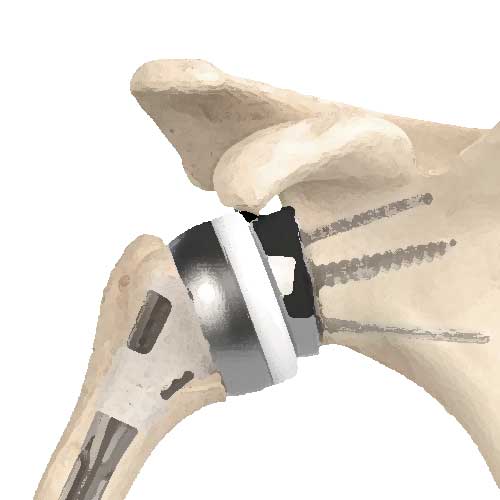
Rotator Cuff Tear
Shoulder Arthritis
What is a Shoulder Replacement?
A shoulder replacement, or also known as shoulder arthroplasty, involves replacing the ball and socket of your joint with an implant. You may need a shoulder replacement for an acute injury, such as a fracture, or if you have severe shoulder arthritis and you have exhausted all non-surgical options. It is a reliable and definitive way to treat shoulder arthritis or a shoulder fracture. The primary aim of shoulder shoulder replacement surgery is to improve your shoulder function by removing pain. A shoulder replacement may also increase your range of motion, especially if you have had associated shoulder stiffness
A shoulder replacement is done through an open incision and is major surgery. You will need time to heal and recover. After surgery, you will have follow-up with a physiotherapist, who will guide you through your rehabilitation and work on your range of motion and shoulder strength.
There are different types of shoulder replacement surgery:
Anatomic Shoulder Replacement
An anatomic shoulder implant is a like-for-like replacement. It aims to restore the normal anatomy of your shoulder. This means, that the ball of you shoulder (humeral head) is replaced with an “ball implant” and the socket of your shoulder (glenoid) is replaced with matching socket implant.
Reverse Shoulder Replacement
A reverse shoulder replacement is when the implants are reversed. This means the socket of your shoulder (glenoid) gets a ball implant and the ball of your shoulder (humeral head) gets a socket implant. This may at first seem like a strange thing to do, but it is a very reliable way to treat very complex shoulder problems. A reverse shoulder implant is used when have a severe fracture of your shoulder or if your rotator cuff is torn and not repairable. It can also be used when you had a previous shoulder replacement by that did not work.
Partial Shoulder Replacement
A partial shoulder replacement, or also known as a hemiarthroplasty, is uncommonly done these days. With this surgery, only the ball of your shoulder (humeral head) is replaced the natural socket (glenoid) is preserved.

Anatomic Shoulder Replacement
This replacement is done when the rotator cuff muscles are intact. The glenoid is resurfaced with a plastic and the humerus is replaced with an implant.

Reverse Shoulder Replacement
The most common type of should replacement. The joint is reversed by replacing the humerus with a socket and the glenoid with a ball.
What is a reverse shoulder replacement?
How long does a shoulder replacement last?
What to expect after a shoulder replacement surgery?

Recovery after a shoulder replacement is variable from patient to patient. Below is a guide of what to expect after surgery. Your recovery time-frame may be different. Dr. Arthur Turow will discuss your particular circumstances and the recovery time-frames with you.
Hospital stay
Most shoulder patients have a nerve block after surgery, which covers pain for 12-36 hours. Once the block wears off, your nurse will start you on pain medication to keep you comfortable. You will need to stay in hospital for 2-3 days after surgery. A physician and physiotherapist will typically review you after your surgery and will guide you through your recovery phases.
First two Weeks
- You will be in a sling during this time
- The focus during this time is pain and swelling management as well as wound care
- A follow-up appointment will be made for you at 2-3 weeks after surgery
Six weeks
- You should be able to resume most daily activities
- Your sling is usually weaned after six weeks
- Your physiotherapist will start working on increasing your range of motion and strength
3 months
- You will start on reconditioning your shoulder by strengthening your muscles and increasing movement
- Most of your pain should have settled by now
- Your range of motion will continue to improve
6+ Months
- You will see incremental increases in strength and range of motion
- Your maximal range of motion will be reached by 12months after surgery, but may still continue to improve up to 18 months after surgery
